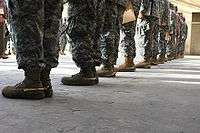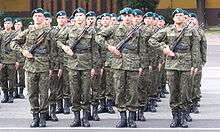At attention
The position of at attention, or standing at attention, is a military posture which involves the following general postures:[1]
- Standing upright with an assertive and correct posture: famously "chin up, chest out, shoulders back, stomach in".
- Arms fixed at the side, thumb or middle finger parallel to trouser or skirt seam, depending on military drill specifics.
- "Eyes front": head and eyes locked in a fixed forward posture. Ideally eyes unmoving fixated on a distant object. Blank facial expression.
- Keeping the heels together, with the toes apart
- No speech, facial or bodily movements except when as required by military drill.
.jpg)

The above stance position is common in most military organizations throughout the world. It may also be adopted by paramilitary organizations, law enforcement, and other organizations requiring a loosely military structure such as Scouts, cadet programs, or police units, or even the Salvation Army.
It is also used in common in civilian marching bands, fife and drum corps and drum and bugle corps. To stand at attention is also a means of saluting when a junior rank meets an officer or superior but he (the junior) is not wearing a cover.
Variations

United Kingdom/British Commonwealth
In the United Kingdom, United States, New Zealand Defence Force and Australian Defence Force, feet are at a 45-degree angle with heels together. In the Canadian forces, feet are at a 30-degree angle with heels together.
Russia/Commonwealth of Nations
On the command of attention (Russian: Смирно; Smer-nah), the soldiers of any sized unit snap their heads to the front, with their chin up and looking straight ahead.[2]
Other nations
- Finnish Army, the distance between the toes should equal the width of two fists.
- Polish Army and Turkish Army, the distance between the halluxes of the feet should equal the soldier's foot's length.
- Swiss Armed Forces, the feet are kept at a 60-degree angle with the heels together.
- Swedish Army, Navy and Air Force, the hands are kept clenched, as a sign of readiness to fight.
- Scouts refer to this position as 'at alert'
See also
References
- Standing Attention Archived May 26, 2007, at the Wayback Machine (from the Centers for Disease Control and Prevention website)
- https://www.13thguardspoltavaskaya.com/drill.html